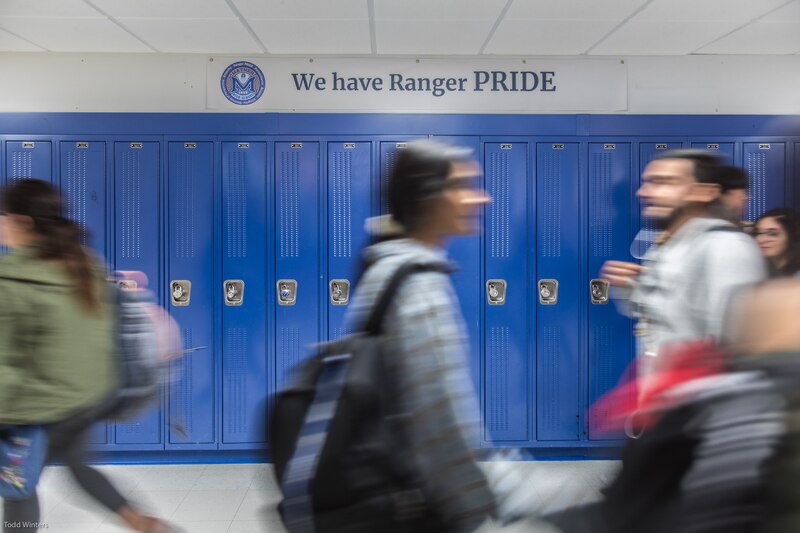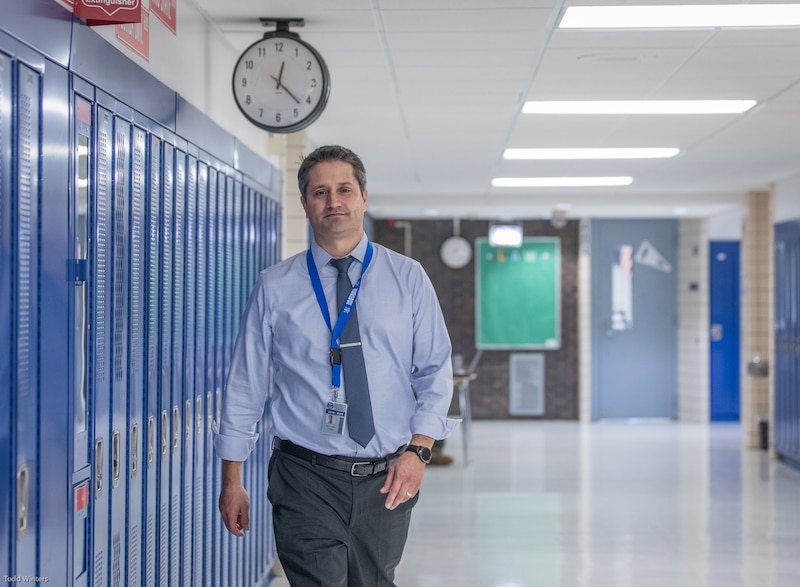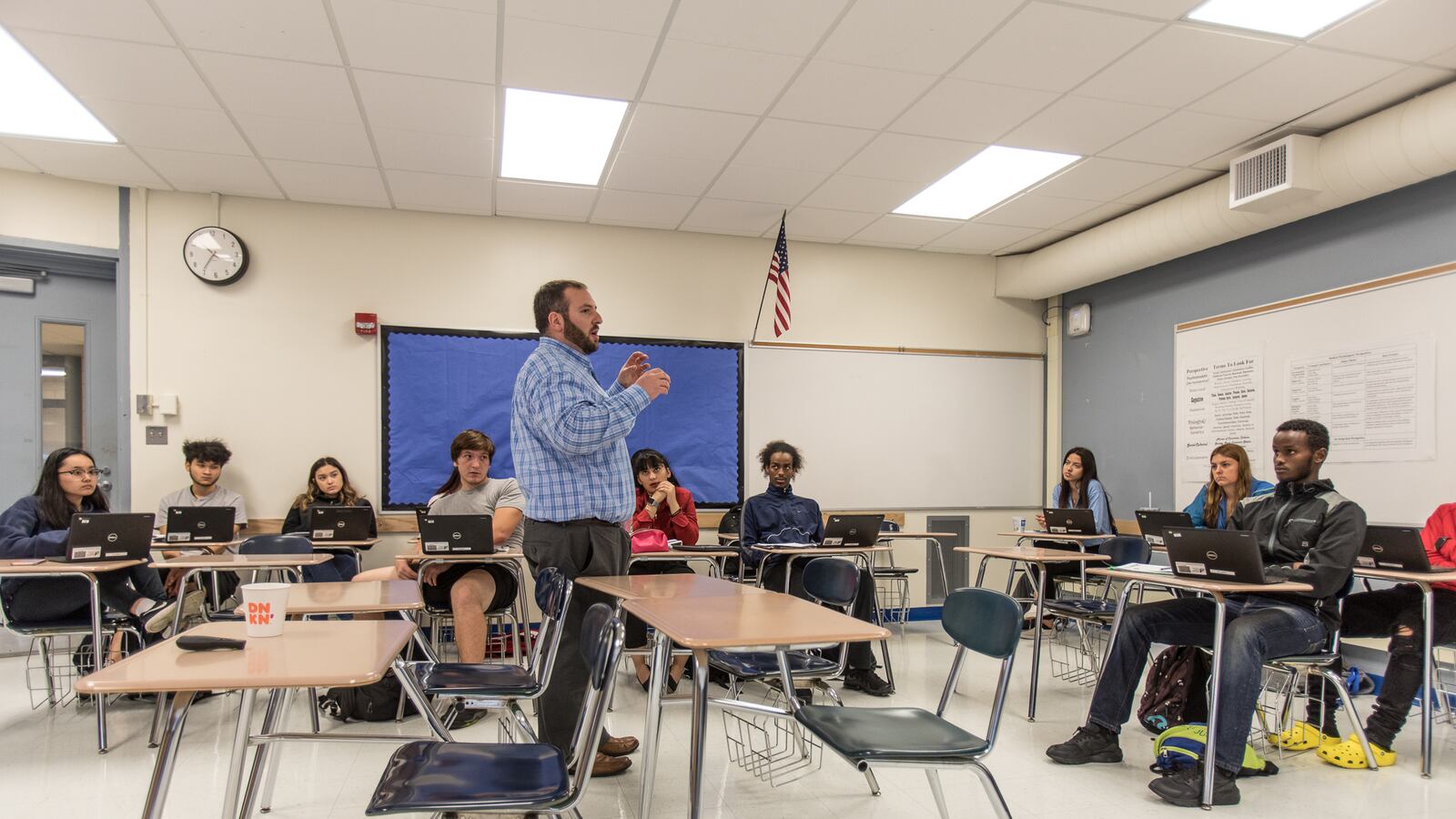
This story was co-published with Crain’s Chicago Business, as part of a Crain’s Forum project on education.
Soon after school started this fall, Eseosa Ogbeifun decided he wanted to drop one of the most challenging courses at Chicago’s Stephen T. Mather High School.
“My friends were like, ‘Why are you taking AP bio?’ It was so hard,” says Ogbeifun, a senior. “I kind of got defeated.”
His counselor, Sara Wong, intervened. “I was trying to get away from that opt-out culture,” she says. “I said, ‘I want you to show up and to try.’ ”
Wong’s response was shaped by training she has received on how to coax students of color like Ogbeifun, who is black, into Advanced Placement classes as part of a two-year-old Chicago Public Schools initiative.
That initiative aims to combat a worrying trend: A broad expansion of AP enrollment in Chicago schools has been driven largely by white and Asian students, with Latino growth slower and fewer black students enrolled in AP courses overall.
AP was designed to give students a shot at college-level work while in high school and to give those who earned at least a 3 out of 5 on a final exam a leg up with college credit. The College Board, the nonprofit that operates the program, honored Chicago in 2017 and 2018 for increasing AP enrollment, particularly among students of color.
But a closer look at the data shows that the growth did not reach all students equally.
As the number of students taking AP courses in Chicago rose by nearly 13 percent between 2014 and 2019, the number of black students taking the courses actually fell by 26 percent. Now, black students make up 20 percent of students in AP courses, compared to 37 percent of the district’s total population.
At the same time, the number of Latino students taking AP courses increased by 17 percent, while the number of white and Asian students shot up. Last year, they made up nearly a third—twice their share of the city’s student population.
Many factors contributed. Chicago’s student population fell by 10 percent from 2014-19, with black students making up the bulk of the decline, but black student enrollment in AP courses fell at a faster rate than the overall black student population. And some schools eliminated AP courses amid enrollment declines and budget cuts, while others adopted a different rigorous curriculum, International Baccalaureate.
Chicago Public Schools CEO Janice Jackson says low expectations for students of color have also played a role—and that’s something the district is working hard to change.
“As a former principal who started an AP program at two high schools—a neighborhood high school and a selective-enrollment high school—I can tell you the challenges were the same: getting people to see beyond test scores and the color of a student’s skin,” says Jackson. “It takes changing a belief system, not only of teachers and administrators, but also changing the belief system of the students, because sometimes they are taught to believe these courses aren’t for them.”

Mather High is a laboratory for what it takes to change that belief system. The diverse West Ridge school draws students with a wide range of academic preparedness. One-quarter of its 1,500 students speak English as a second language, and nearly 90 percent are from low-income families.
Five years ago, about 250 Mather students took AP courses. Last year, that number was 500. Recent gains have come close to making AP enrollment proportional across racial groups—a rarity in the city school system.
What changed, according to Principal Peter Auffant, is that in 2017 Mather began working with a nonprofit group called Equal Opportunity Schools to identify more black and Latino students who could succeed in AP courses. (The group began working with six Chicago high schools in 2017 and now works with 12, at a price tag of $235,000 a year.)
“We have had to change the mindset of teachers about why potential students are getting missed, and change the traditional narrative about what AP students are,” says Auffant.
The consultants put the entire Mather staff through an implicit bias exercise to challenge perceptions about students’ abilities by race. The group surveyed every student about goals, possible roadblocks and enthusiasm for taking AP classes. And it helped launch a system that flags students whose interest and test scores make them good candidates for enrolling.
“There are kids who say, ‘Sign me up—no one ever asked me to be in an Advanced Placement course before,’ ” Wong says. “But then there are others who are hesitant. We target those students, and, often, when we talk to them, they tell us they are afraid of failing.”
But educators say how students perform on the courses’ final exams is beside the point. “I’m trying to focus more on the question of, what are they coming in with and what are they leaving with? And how does that set them up for the next class?” says Daniel Izzo, who teaches AP psychology. Only 1 in 5 students who took that exam last year earned a passing score, he says. (The city’s overall pass rate has risen sharply even as more students have taken the exams, to 50 percent in 2019.)

More significant, Auffant says, is that students see that the adults around them believe in their ability to tackle high-level work.
Nearly every staffer at Mather comes in early, stays late and pitches in to ensure the teenagers persist. Tim Odueyungbo, a 17-year-old senior, says his basketball coach launched a pre-practice study hall after four players began taking AP courses. Another student says his AP calculus teacher has been tutoring students starting at 6:30 a.m. A counselor started a stress-and-anxiety club that teaches meditation.
“Teachers are offering to help even after school on Fridays, or during their lunch periods, or their free times,” says Oswaldo Grajeda, a sophomore taking AP U.S. history.
After two years of Chicago’s more concerted AP enrollment push, there is some evidence it’s working. At the initial six schools in the Equal Opportunity Schools pilot, AP enrollment was 30 percent higher last year than in 2017, and students of all racial groups enrolled.
Principals districtwide have been encouraged to look at their data and act on it, and the proportion of black AP students at campuses that offer the courses has subsequently risen by 5 percentage points in just two years. And some students are taking a different set of advanced courses, International Baccalaureate, which is now offered on 22 campuses, often in lieu of AP.
But if Mather is any example, the burden on already-taxed school staff is steep—and, at least according to research, the benefits for students are unclear.
“It requires a lot of work from a teacher—and sometimes rethinking how you teach,” says Suneal Kolluri, a researcher at the University of Southern California’s Rossier School of Education.
Last year, Kolluri examined 50 studies of AP tests and classes and found little evidence that students who take the courses do better in college later, or that AP courses are better than career or dual-enrollment courses at getting students on track for later success. (Chicago is expanding those offerings, too.)
But people on the ground say they are already seeing the benefits. At Peace & Education Coalition Alternative High School, Principal Brigitte Swenson last year assigned 20 students to AP Spanish—practically unheard of at a school designed for students who have struggled. (The school is not part of the Equal Opportunity Schools initiative.)
“Their initial response on the first day of the class was complete shock,” Swenson recalls. “Some said, ‘You gotta be kidding me. We’re taking AP here?’ And the messaging back to them was, ‘You can do this.’ ”
In the end, Ogbeifun, who wanted to drop AP Biology at Mather, accepted the challenge. The talk with his counselor stuck with him. So did a similar conversation with his biology teacher.
“She said she has high hopes for me,” Ogbeifun recalls. “She said, ‘I think you could do this.’ And I decided, you know, why not?”

